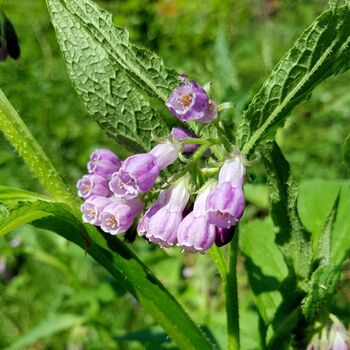
How to Grow Comfrey Seeds
Grow Guide #2400
Family: Boraginaceae
Binomial name: Symphytum officinale
Life Cycle: Perennial
This 'How to Grow' guide details everything a home gardener needs to know to plant, grow and care for Comfrey (Symphytum officinale).
When to Sow Comfrey Seeds
Comfrey is a perennial plant that grows year round in most climates. Use the table below to identify the best time of year to sow comfrey seeds in your climate.
| JAN | FEB | MAR | APR | MAY | JUN | JUL | AUG | SEP | OCT | NOV | DEC | |
|---|---|---|---|---|---|---|---|---|---|---|---|---|
| Cool | ||||||||||||
| Temperate | ||||||||||||
| Sub-Tropical | ||||||||||||
| Tropical | ||||||||||||
| Arid |
Preparation
Comfrey plants can be difficult to eradicate once they are established in the garden. Choose a permanent position in a garden bed or grow them in containers to prevent them spreading into unwanted areas.
Comfrey plants commonly self-seed in the garden. Self-seeding plants drop seeds onto the soil at the end of the season that may germinate and grow without help the following season. Choose a position where new plants will be welcome. If you do not want comfrey to become established in your garden, deadhead plants before they can drop seed or grow them in containers.
Comfrey plants are best grown in full sun or part shade. Choose a location that will receive at least 3 hours of full sun each day.
Comfrey plants need a well drained soil enriched with plenty of organic matter. Prepare soil by weeding it thoroughly, digging it over to loosen it and adding aged animal manure or compost. Keep the area free of weeds until planting. Learn more about preparing soil for planting here.
Comfrey plants can be grown in containers. If possible choose a variety that’s recommended for container growing. Use a good quality potting mix and make sure your container is large enough for mature plants; a minimum of 20 litres is recommended for comfrey. During the growing season, keep in mind that container grown plants may need additional fertiliser to encourage healthy growth.
How to Sow Comfrey Seeds
Optional: Stratifying seeds prior to planting may improve the speed and success of germination. Stratification involves exposing the seeds to a period of cold temperature which for some species helps to break dormancy and spur the seeds to germinate. Read more about stratification here.
Comfrey seeds grow best when they are raised in trays or other containers and transplanted to the garden once established.
- Fill trays, punnets or jiffy pots with a good quality seed-raising mix, or use soil starter pellets.
- Sow seeds 5mm deep.
- Keep soil moist but never wet or dry.
- Seeds should germinate in around 25-30 days at a soil temperature of 20-22°C.
- Transplant seedlings to the garden once they have their first true leaves and are large enough to handle (usually 5-10cm tall).
- Plant out, spacing plants 60cm apart.
Tip: Seeds of this variety can be slow to germinate. Take note of the expected germination time, be patient and follow the recommended depth and temperature guidelines closely for the best chance of success.
How to Grow Comfrey
Comfrey plants may need watering during the growing season. Water when the soil is dry about 5cm below the surface (test this by scratching away a little soil with your finger). Water deeply in the early morning or late afternoon. Avoid watering the leaves of plants to avoid fungal diseases. Learn more about watering here.
Comfrey plants will grow in nutrient-poor soils and do not need additional fertiliser during the growing season.
Comfrey plants may die back in cold weather. Cut plants back just above ground level in late autumn, or prune off dead foliage when new leaves emerge in spring.
Comfrey should be ready to harvest in approximately 365 days.
Comfrey leaves can be used to make compost tea or added to chop and drop mulch or compost. Harvest individual leaves by cutting them off at the base, starting with the outer leaves and leaving some on the plant for future growth. Alternatively, harvest the entire plant in autumn; leaves will regrow in spring. Harvest leaves sparingly the first year.
Common Problems when Growing Comfrey
Like all plants, comfrey is susceptible to some pests, diseases and other problems. Below is a list of the most common problems gardeners encounter when growing comfrey plants:
 Rust (Puccinia sp.) is a fungal disease that causes brown to orange raised spots or patches to appear on foliage. Fungal spores are spread by wind or water to neighbouring plants, especially in temperatures of 10-20C and when humidity is high. To manage rust, space plants to avoid overcrowding, grow them in the recommended amount of light (eg full sun), do not over fertilise crops, remove dead plants and practice crop rotation. Read more about rust fungus here.
Rust (Puccinia sp.) is a fungal disease that causes brown to orange raised spots or patches to appear on foliage. Fungal spores are spread by wind or water to neighbouring plants, especially in temperatures of 10-20C and when humidity is high. To manage rust, space plants to avoid overcrowding, grow them in the recommended amount of light (eg full sun), do not over fertilise crops, remove dead plants and practice crop rotation. Read more about rust fungus here. Slugs and snails are molluscs that feed on tender leaves and shoots, mostly at night, leaving slimy trails behind them. Control them by removing their hiding places, keeping free range poultry, collecting them by torchlight or by placing traps. Read more about slugs and snails here.
Slugs and snails are molluscs that feed on tender leaves and shoots, mostly at night, leaving slimy trails behind them. Control them by removing their hiding places, keeping free range poultry, collecting them by torchlight or by placing traps. Read more about slugs and snails here.


.png)



